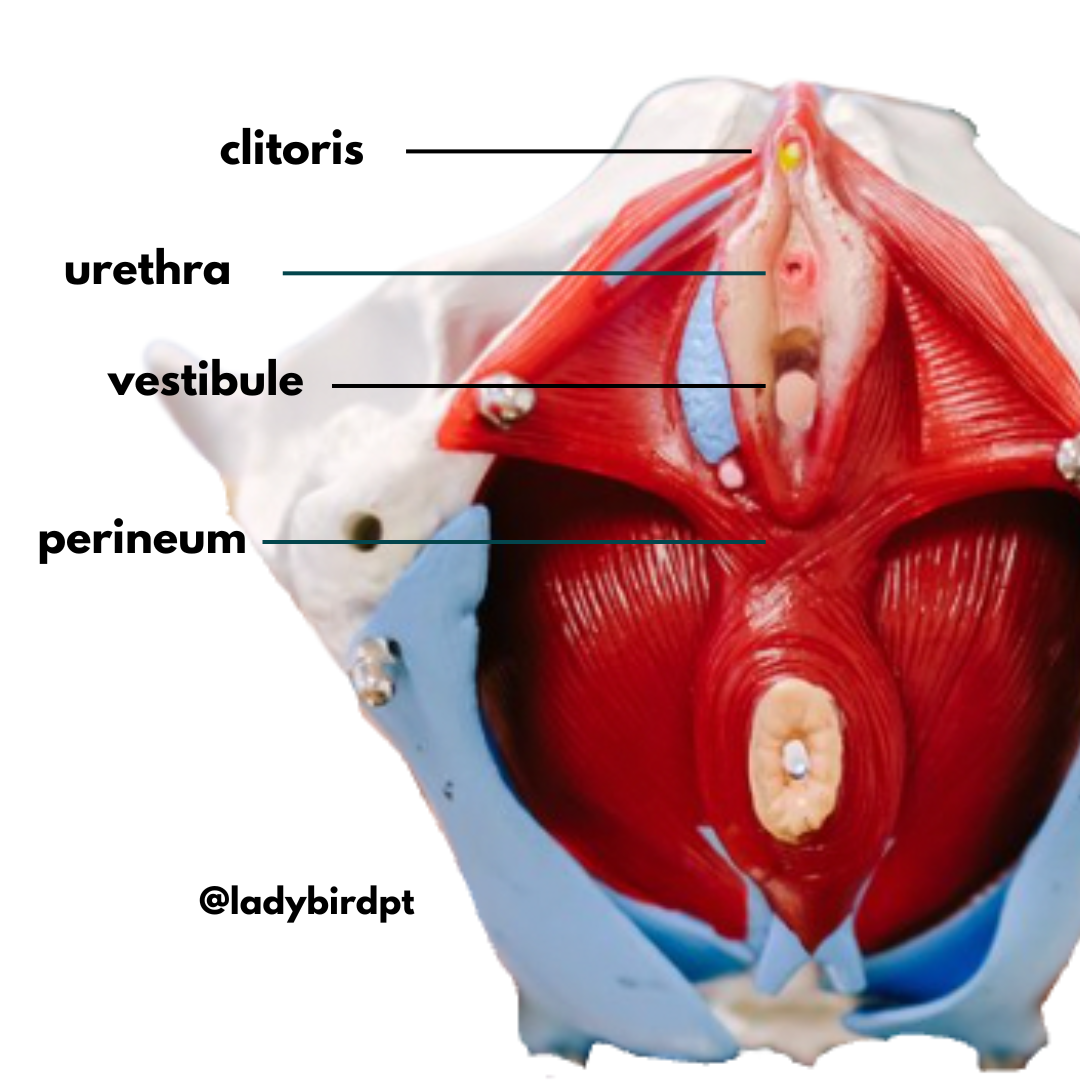Where You Hurt During Sex Can Help Determine Why You Hurt
Up to 42% of people experience dyspareunia, or pain with sex, after childbirth. But not all pain with sex is created equal. Where you hurt can give us major clues as to why you hurt, and what we can do about it.
When folks come in to see a pelvic floor physical therapist in the clinic for pain with penetration, a question they’ll likely encounter is about the location of the pain. For many, that’s a hard question to answer. If you don’t spend the majority of your day talking about parts of the vulva and vagina (just me?) it can be difficulty to determine where the pain that you’re experiencing stems from.
Here are some common locations of pain with sex so you can think about the answering the location question for yourself:
clitoral pain
urethral pain
vestibular pain (pain at the vaginal opening)
deeper vaginal pain
perineal pain
tailbone pain
abdominal pain
Where you hurt matters and different locations of pain may indicate different potential causes. Common causes of pain with sex postpartum include hormones, muscles and scar tissue. While it’s common for people to experience pain as a result of multiple factors, the location of the pain may serve as a useful guide for your PT to begin formulating their hypothesis of why you hurt.
Before we continue - it’s important to remember that the information below is meant to serve as a guide and each individual case is different. If you’re experiencing pain with sex, it’s important to speak with your medical provider to rule out underlying medical causes and get appropriate care. While there are a number of causes of pain addressable with physical therapy, pelvic pain and pain during intercourse can be a sign of infection and underlying diagnoses that require medical treatment.
With all of that said, here are common trends associated with location of pelvic pain:
Pain at the vestibule (vaginal opening) or urethra: The vestibule, also known as the vaginal opening, is highly hormonally dependent. As a result of that hormonal dependence, pain at the vaginal opening or the urethra, may indicate a hormonal issue. Those with a history of oral contraceptives may have decreased testosterone levels and those who are currently lactating may have low estrogen. Low levels of these hormones at the vaginal opening can cause sensitivity and pain during initial penetration and can irritate the urethra as urethral tissue is hormonally dependent as well. While pelvic floor physical therapy can help folks with hormonally driven pain, a topical hormone cream applied as prescribed by your MD will help as will a good lube.
Perineal pain: Pain at the perineum can be confused with pain at the vaginal opening, but true perineal pain is less likely to be hormonal. Most often when folks are experiencing perineal pain postpartum it’s due to scar tissue as a result of perineal tearing or muscle overactivity as a result of guarding against the pain. Perineal tearing occurs in up to 85% of vaginal births and while the majority of that tearing is mild, even a mild tear can contribute to perineal discomfort during penetration after childbirth. If you’re experiencing pain at the site of your tear or in the perineum, assessing scar mobility and muscle tone and treating the underlying restrictions can help.
Pain deeper in the pelvis or abdomen: Pain near the cervix or deeper in the pelvic bowl can often be related to muscular sensitivity or tightness or cervical positioning. Other factors that may contribute to deeper pelvic and abdominal pain often include coccyx injury, visceral restrictions and can include conditions like endometriosis. Pelvic floor physical therapy may include manual (hands on work) to address the musculoskeletal and visceral restrictoins or mobilize the cervix and tailbone. It’s also important to rule out constipation and other medical conditions.
The reality is that it’s common for people to have pain in multiple places or to have a number of the above factors contributing to their pain. But identifying the location of your pain is a great starting point.
To learn more about how pelvic floor physical therapy can help you reduce pain and improve pleasure during sex, contact us here!
This post was written by Dr. Rebecca Maidansky, PT, DPT, owner and founder of Lady Bird Physical Therapy. Rebecca is a pelvic floor physical therapist in Austin, TX and founded Lady Bird Physical Therapy in 2019. She is the creator of Birth Preparation and Postpartum Planning, Baby Steps Fitness and the head writer and editor of The Pelvic Press.
Rebecca is a passionate writer and vocal advocate for pelvic health and the importance of improving access to perinatal care. She believes strongly that many common pregnancy pains and postpartum symptoms can be eased or even prevented with basic education and care.
She created this blog to help all birthing people manage common pregnancy pains, prepare for birth and recover postpartum.


